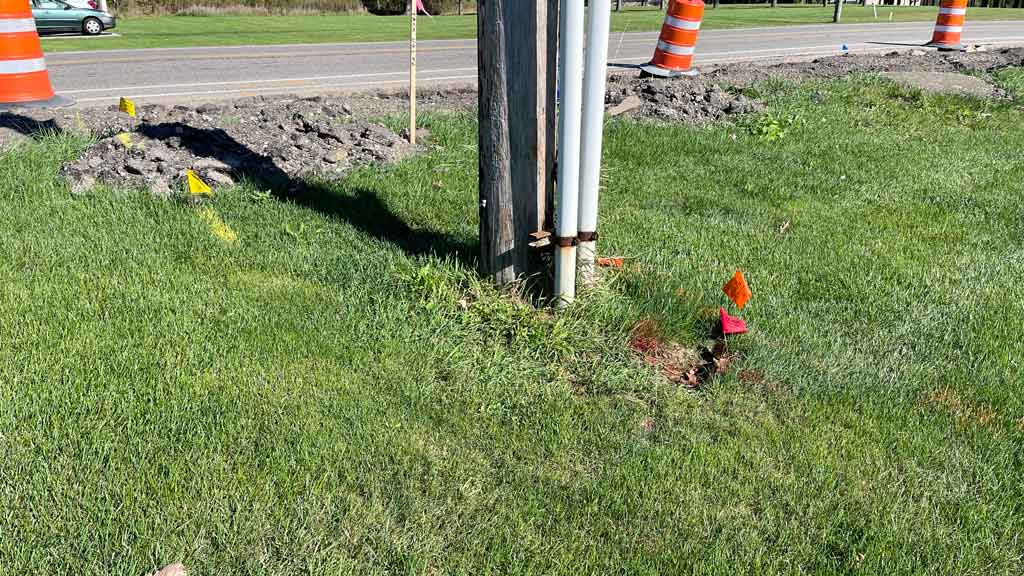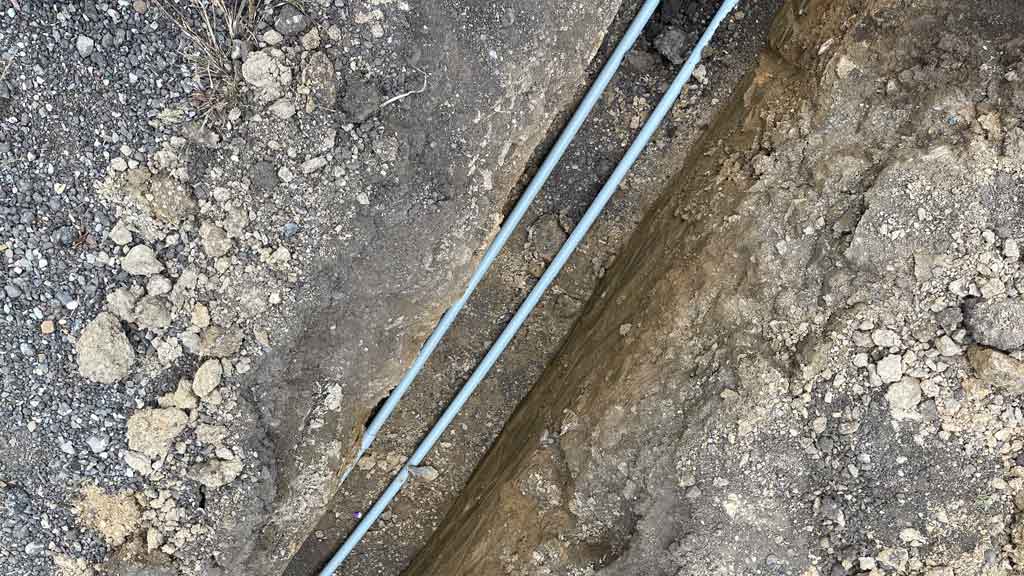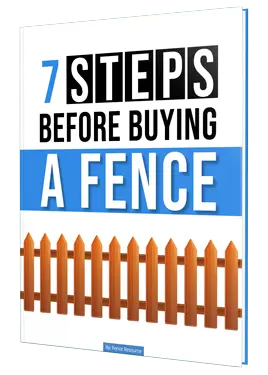Locating services do not mark privately installed lines. They fall into a category known as unmarked buried lines. There are many type of lines that go unmarked. Not only do they make digging more challenging but also potentially dangerous.
Before digging of any kind commences, it is important to call in a ticket from your local utility locating agency. These agencies send out representatives to mark public utilities, based on the address provided, from the right of way to private dwelling.
Locating services will mark most public utilities. These include gas lines, electric lines, water, cable and telephone lines. Paint and flags of specific colors indicate each type of buried line.
Fence on an Easement – Can you Build One?
Avoid digging near marked lines when possible. When there is no other option, use extreme caution. Dig by hand. Do not use powered digging equipment.
All other lines are unmarked buried lines. In this article, we’ll learn more about the different types of unmarked lines. We’ll also discuss what options you have when digging near them.

Unmarked Buried Lines for Utilities
We just learned that there are public agencies that mark utilities lines from the public right of way to private dwellings. However, utility lines exiting dwellings are classified as private.
Public locating services do not mark private lines. At least not for free. The two most common private utility lines are gas lines and electric lines. Below are examples of where to find private gas and electric lines.
Gas Lines
Private gas lines are very common. Especially when a customer has a swimming pool with a heater. Pool heaters require a gas line in order to operate. Therefore, a gas line must be ran from the house.
If your pool contractor was smart, hopefully they documented where the line was ran. However, from my experience, most don’t think about installing fence posts when running the line. As a result, it becomes a guessing game for the fence contractor.
Outdoor fire pits and Barbecues also require private gas lines. However, most times these line are not ran far from the house. Furthermore, they normally run to a patio or location far away form where fence posts would be.
Electric Lines
We run into private electric lines quite often. Detached garages and sheds require electric lines for power. Many are ran overhead. In this case they are visible and will not effect digging.
Buried private electric lines are the problem. Often installed when a home is originally constructed. Depending on the age of the home, multiple homeowners could have come and gone.
As a result, the location of the line is unknown. Leaving the contractor digging near or around it at high risk.
Unmarked Buried Private Lines

We just learned about public utilities and at what point they become private. We also looked at a few scenarios at where we would find those types of unmarked buried lines. However, there are many more types worth discussing.
The good news is, that hitting any of the following unmarked buried lines won’t cause a safety hazard. However, some will cause a major inconvenience. Some of these lines you are able to fix on your own if hit. While others may require calling in a service repair person to fix.
The four most common unmarked buried lines we run into while digging other than utility lines are as follows. Pool lines, sprinkler lines, invisible dog fence lines and septic or sewer lines.
So let’s look take a deeper look into these types of lines. We’ll review some examples and discuss what to do in the unfortunate case you hit one while digging.
Unmarked Pool Lines
The lines between pool equipment and swimming pools are always underground. Unfortunately, if you weren’t present when ran, you probably have no idea where the pool lines are located. If you are, take detailed pictures and measurements of where they are located.
Even if you were present during construction, most homeowners pay no attention to where the contractor lays the lines. At least not enough to allow for certainty when digging.
Pools have three common types of unmarked buried lines. Gas and electric are two. However, we’ve already touched on those. The third are the water lines for the pumps and filters.
Most pool companies install these types of lines well below grade. However, not always. These are lines that are not easy to fix. Furthermore, hitting one creates a big mess. Especially for water filled pools.
To make matters worse, pool lines are PVC pipe. So even when hand digging, there is a chance for breaking a line. Use extreme caution when digging around or near pool lines.
Unmarked Sprinkler Lines
I can’t tell you how many times I’ve hit a sprinkler line. Unfortunately, there is no good way to mark them. Furthermore, sprinkler companies don’t document the locations of the lines when installing. I believe because they are so easy to move or repair.
I’ve been on countless jobs where sprinkler heads are located on the incorrect property. Either the customers heads are on the neighboring property or vise versa. Again, easy to move and fix. So Sprinkler installation companies don’t take the time to run string lines or establish property lines.
Water will rush from the ground after hitting an active sprinkler line. An inactive line will not. However, the black plastic remnants of sprinkler line pipe will be visible.
There are many splice kits available for repairs. They are easy to fix and costs are minimal. However, if it seems like more of a task than you are willing to tackle, call your sprinkler company. They will be happy to assist you.
Unmarked Invisible Dog Fence Lines

Many homeowners have invisible dog fences. An electrified wire running the perimeter of the containment area triggers the dog collar. The good news is the collar makes an audible sounds. As a result the wire is traceable.
The bad news is, everyone installs invisible dog fence on their property lines. This is a smart thing to do in order to maximized the enclosed area. However, digging fence post holes often leads to the wire getting cut.
Invisible dog fence wire is cheap and easy to fix. So if yours get’s cut, purchasing a repair kit will get you back going in a matter of minutes. Although, if you are installing a permanent fence, you may not care if it stays cut.
Unmarked Septic Systems Lines
The last type of unmarked buried lines are septic and leach field lines. However, they are not usually located on the property line. Therefore, if you are digging holes for a fence installation, there is a good chance they will never come into play.
Neither are easy to mark. However, in grassy areas, usually you can see where the lines are located. Look for areas in the yard that are greener than the rest. They should be in lines. Many times there is also a curtain drain.
Curtain drains are closer to the perimeter of the yard. They are filled with gravel. Exposed gravel is easy to see. When it isn’t exposed, look for a recessed area in the lawn providing a visible clue as to where it is located.
The good news is they are easy fix if damaged. A trip to your local hardware store will take care of the parts required to fix a broken line.
Who is Responsible for Unmarked Buried Lines?

You would think that the person digging near unmarked buried lines is responsible when one gets hit. However, that isn’t always the case. When you are the one digging, you are the one who is responsible.
It is important to discuss this possibility before hand with your contractor. Here is how most contractors handle the digging around lines.
Any line that is marked, then hit after calling in a ticket to the local utility locating service is the contractors responsibility. But we are talking about unmarked buried lines. Here’s how my company handles them.
If you don’t know where they are located, we surely don’t know. Give us a heads up to where you think they are located and we do our best to avoid or hand dig near them.
However, when unsure, we recommend using a private company to locate unmarked lines. If the customer decides, we dig with the understanding we are not responsible for any damage. Of course we will inform the customer of any hit lines, but we do not take responsibility.
Now, we also do our best to dig up and expose the broken ends to make the repair easier. Many times, even though we do not take responsibility, we do fix it in order to keep the project moving. But we have the discussion ahead of time so there is no confusion.
Private Utility Locators
So, after all this talk of hitting and breaking unmarked lines, there’s gotta be a way to have them marked, right? Yes, you are correct. However, as long are you are willing to assume extra costs.
Private utility locators mark lines that public utility locators won’t or can’t. However, there are different kinds. Some have the same locating tools as the public services. They are good for locating private electric or gas lines. Especially when a tracer wire is visible.
For all other lines that don’t, you will need a locator with ground penetrating radar. This type of locator will not only tell you where the unmarked buried lines are located, they can tell you how deep they are too.
Either type will cost you. From my experience, the extra cost ranges between $300 to $800 dollars. This is what most repairs would cost anyway. So contracting a private locator does add an extra expense, but one that is equal to the cost of a repair.
At this point, I believe it is worth it to hire one. Ensuring accurate digging without damage to any lines. It also provides stress free peace of mind. Sort of like having insurance.
The decision is yours. One type of customer is the gambler. Crosses their fingers and rolls the dice. The other is more prepared. Dots all the I’s and crosses all the T’s. In a perfect world, you won’t have any unmarked buried lines a will not have to make that decision.

